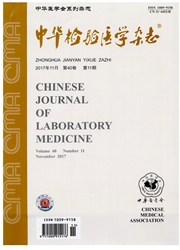

 中文摘要:
中文摘要:
目的研究我国多中心亚胺培南耐药的鲍曼不动杆菌的耐药性、16SrRNA甲基化酶的阳性率及分子流行病学特征。方法收集2004年11月-2005年11月国内6省市19家医院临床分离的342株亚胺培南耐药的鲍曼不动杆菌。采用琼脂稀释法和Etest法对18种抗菌药物测定分离株的最低抑菌浓度(MIC)值;脉冲场凝胶电泳(PFGE)分析菌株的同源性;PCR法筛选4种16SrRNA甲基化酶基因armA、rmtA、rmtB、rmtC,克隆测序明确基因型;接合试验、质粒抽提、电转化以及Southern blot确定甲基化酶耐药基因定位。结果所有菌株均为多重耐药株,其中对阿米卡星、庆大霉素、妥布霉素、异帕米星、奈替米星耐药率分别为92.6%、98.6%、87.4%、90.9%和92.4%。PCR扩增、测序证实221株鲍曼不动杆菌检出甲基化酶armA基因;另3种甲基化酶基因rmtA、rmtB、rmtC均阴性。在上述342株鲍曼不动杆菌临床分离株中,298株可归类为6个流行克隆,44株为散发株。3个主要克隆(A、B、C)在全国广泛播散,分别在国内6家、3家、11家医院内流行。接合试验、质粒抽提、电转化及Southern blot表明armA编码基因存在于染色体上。结论亚胺培南耐药鲍曼不动杆菌的表型均为多重耐药。介导氨基糖苷类抗生素高度耐药的16SrRNA甲基化酶基因armA在鲍曼不动杆菌中广泛存在,其主要传播方式为克隆播散,这必将引起临床的高度关注。
 英文摘要:
英文摘要:
Objective To investigate the antimicrobial resistance and prevalence of 16S rRNA methylases in imipenem-resistant Acinetobacter baumannii strains isolated from 19 hospitals of 6 provinces in China and to analyze their homology. Methods Three hundred and forty-two clinical isolates of imipenem-resistant A. baumannii from Nov. 2004 to Nov. 2005 among 19 hospitals in China were collected. Agar dilution and E test were used to determine the MIC of 14 antibiotics. The homology of these isolates was analyzed by pulse-field gel electrophoresis (PFGE). Four 16S rRNA methylase genes, armA, rmtA, rmtB and rmtC were detected by PCR-based assays and PCR products were purified, cloned and sequenced. Plasmid DNA was extracted and conjugation and Southern blot were also performed to locate the armA gene. Results All of the 342 strains were characterized by a multi-drug resistance phenotype, including amikacin, gentamicin, tobramycin, isepamicin and netilmicin, with resistant rates of 92.6% , 98.6%, 87.4%, 90. 9% and 92.4%, respectively. Total of 221 were positive for armA gene. These strains distributed in 17 tested hospitals. No rmtA, rmtB or rmtC gene was detected. Among the 342 clinical A. baumannii isolates, 298 strains could be classified into 6 epidemic clones, and other 44 strains were sporadic. Clone A, B and C are 3 main clones, which spread widely among 6, 3 and 11 hospitals, respectively. Conjugation, plasmid extraction, electrotransformation and Southern blot confirmed that the armA coding gene is located on the chromosomes of the isolates. Conclusion Imipenem-resistant strains of A. baumannii had highly resistant rate to different antibiotics including aminoglycoside agents. It is surprising that the armA gene, which confers high-level resistance to all the clinically available aminoglycosides, distributed so widely in A. baumannii in China. The clone spread of armA-positive A. baumannii isolates existed widely in Chinese hospitals. The spread of the multidrug-resistant isolates producing 16S rRNA methylases ma
 同期刊论文项目
同期刊论文项目
 同项目期刊论文
同项目期刊论文
 期刊信息
期刊信息
